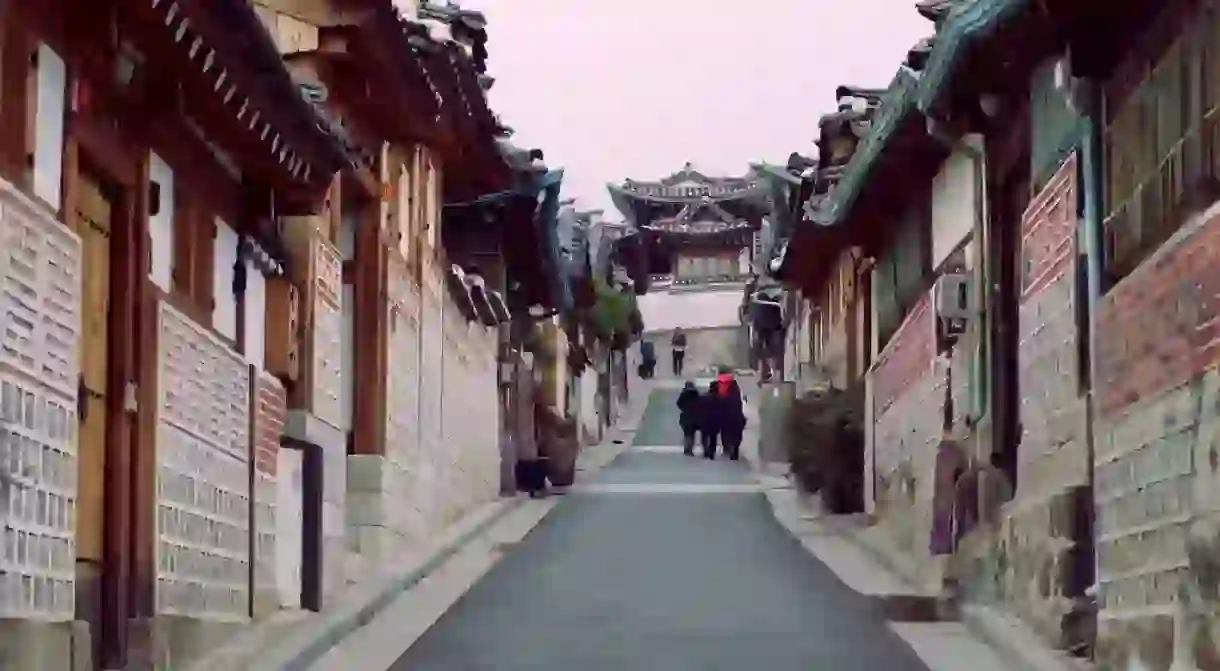Explore Korea's Traditional Arts at the Workshops of Bukchon Hanok Village

Rooted in 600 years of history, Bukchon Hanok Village is without a doubt the best place to take in traditional Korean architecture in Seoul. But the neighborhood is also home to some 20 workshops and studios where visitors can get an up-close look at Korea’s traditional artworks, meet master craftsmen, and even learn a craft themselves. Here’s a list of our favorites.
Cho Kyung-wha Dakpaper Doll Workshop (조경화 닥종이 공방)
Art Gallery, Museum
At the Cho Kyung-wha Dak Paper Doll Workshop, visitors can learn about and experience the charms of hanji, or traditional handmade paper. The soft yet durable paper is crafted using a labor-intensive, 10-step process and is often utilized in the production of traditional Korean crafts. Among them include artwork, housewares, and dak (referring to the Korean Mulberry tree from which the paper materials come from) paper dolls, in which the workshop specializes. Generally illustrating some sort of aspect related to childhood in Korea, these dolls are cherished by all ages. A wide variety of them – crafted by masters and craftsmen – are beautifully displayed in the workshop, with some of the most noteworthy depicting 1960s Korea. The workshop also provides daily activities as well as a 12-week program where visitors can learn more about the handicraft and even try their hand at making their own hanji doll.
Dong-Lim Knot Workshop (동림매듭박물관)
Museum, Art Gallery
Generally made using a single string of silk and incorporating various techniques, Korean knots have long been utilized in traditional clothing and room décor. Those looking to explore this age-old handicraft can visit the Dong-Lim Knot Museum in Bukchon, which exhibits a variety of ornamental knots such as norigae for hanbok, belts and pouches, as well as the materials that are used to make them. Workshop curator and traditional knot craftswoman Shim Young-mi is the fourth generation of her family to preserve the traditional techniques of the craft, which were used to create royal clothing during the Joseon Dynasty. Today, Shim has been involved in reproducing the king’s seal and restoring the tassels of the royal portrait of King Taejo, which hangs in Jeonju. Should you want to get more hands on, the museum offers a one-day maedeup class and a long-term program taught by an apprentice of Shim’s. To participate, call the museum at least two days in advance.
Haneul Mulbit Workshop (하늘물빛)
Art Gallery, Museum

As one of the oldest Korean traditions, natural dyeing uses ingredients like persimmon or anil (a plant used to make an indigo color) to produce fabrics in a number of beautiful colors. Even though the majority of the country’s traditional dyeing processes have been replaced by machines and artificial chemicals, a handful of artists continue to pass down the traditional way. Among them is 75-year-old Cho Soo-hyun, the owner of Haneul Mulbit, a workshop dedicated to traditional Korean knotting, dyeing, and patchwork. Here, Cho, with a little help from her son Lucas Hong, a researcher of traditional dyeing, and her daughter Hong Gwang-hee, who studies traditional patchwork, draw in a wide variety of visitors of all ages eager to learn more about Korea’s age-old handicrafts. Visitors to the workshop can appreciate a wide collection of finely dyed fabrics, threads, and embroidered works, and partake in a workshop to better understand why Korea’s traditional dyeing techniques have been designated as an intangible cultural asset.
Kum Bak Yeon Gold Leaf Imprinting Workshop (금박연)
Museum, Art Gallery
As gold was once a symbol of eternity, beauty, and authority, gold leaf was often incorporated into the apparel of Korea’s royal families to mark their authority and illustrate their aspirations for national prosperity. Perhaps no place preserves this traditional art better than the gold leaf imprinting workshop Kum Bak Yeon. This imprinting business has been around since 1861, when it was founded by Wanhyeong Kim, who imprinted golden embroidery onto the clothing and furniture of King Cheoljong (1849-1863) of the Joseon Dynasty. Since then, it has been passed down through the generations. Subsequent owners have included Wonsun Kim, who worked as the imperial golf leaf decorator for the state funeral of the Empress Myeongseong, Gyeongyong Kim, who served the last imperial family of the Korean Empire, and Deokhwan Kim, who is the holder of these important, intangible cultural assets. Here, visitors can see each step of the imprinting process with full explanations and, if they have a reservation, can try it out for themselves.
Chilwon Lacquer Workshop (칠원 칠기 공장)
Museum, Art Gallery
Established to promote the diverse lacquering culture of Korea, the Chilwon Lacquer Workshop was founded by Lee Jong-heun, who has been researching the various lacquering techniques of Asia for more than three decades. The workshop, which is housed in a hanok (traditional Korean house), boasts approximately 300 pieces of lacquer-related relics, some 200 artworks created by Korean artists, and more than 20 lacquered paintings that each in their own way showcase the beauty and vibrancy of the country’s traditional art. Visitors can also experience lacquer painting for themselves or purchase artwork from the gift shop.













